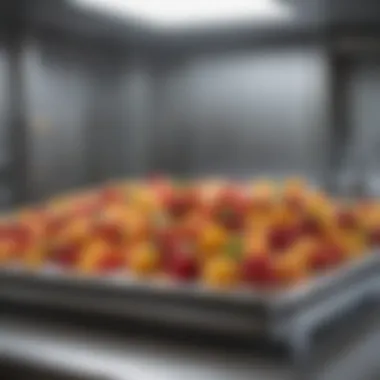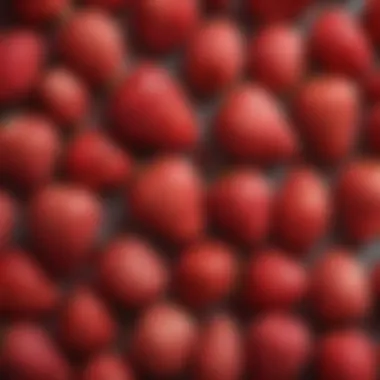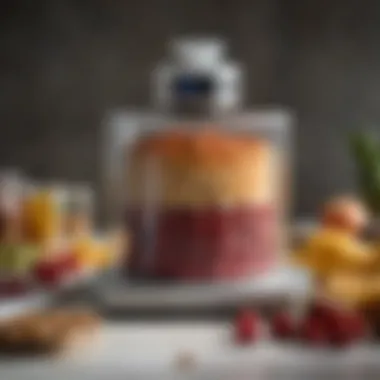Understanding Freeze Drying Fruit: A Comprehensive Guide


Intro
Freeze drying, a method employed for preserving a wide variety of food items, has gained significant traction in culinary and preservation circles. This process, particularly for fruits, serves to retain their nutritional integrity, flavor, and visual appeal. Understanding the precise mechanics of freeze drying is essential for anyone interested in high-quality food preservation. It allows consumers to enjoy the benefits of fruits even when they are out of season and to utilize them in various culinary applications.
The basics of freeze drying revolve around the principle of sublimation. This is where moisture in the fruit transitions directly from ice to vapor, bypassing the liquid phase. This method not only prevents spoilage but also enhances the shelf life of fruits while maintaining their essential vitamins and minerals. Moreover, as the freeze-drying process is gentle, it preserves the natural colors and shapes of the fruits, making them visually appealing as well. However, it is important to distinguish between freeze-dried and dehydrated fruits, as the methods and outcomes can vary considerably.
As we delve further into this article, the reader will encounter a thorough exploration of the various steps involved in the freeze drying process, the necessary equipment, and potential obstacles that one might face. Additionally, we will analyze the advantages and disadvantages of freeze drying, alongside its practical applications in both home kitchens and commercial settings.
This comprehensive guide will serve to illuminate the freeze-drying process, making it accessible not only for culinary enthusiasts but also for novice food preservationists. With an understanding of this innovative technique, one can elevate their culinary repertoire and make informed choices about preserving fruits for future use.
Intro to Freeze Drying
In recent years, freeze drying has gained attention for its effectiveness in preserving fruits without compromising their essential qualities. Understanding the process of freeze drying is not just important for scientists and food technologists, but it is also valuable for culinary enthusiasts and anyone interested in food preservation. This article aims to provide a comprehensive guide that demystifies the steps involved in freeze drying fruits, its benefits, and the considerations to keep in mind.
Definition of Freeze Drying
Freeze drying, also known as lyophilization, is a preservation technique that removes moisture from food items, primarily to extend their shelf life. The process involves freezing the fruit at extremely low temperatures and then reducing the surrounding pressure, allowing the frozen water in the fruit to sublimate directly from ice to vapor. This unique method retains the flavor, color, and nutritional value of the fruit much more effectively than traditional drying methods.
Historical Context
The concept of freeze drying has its roots in military and emergency preparedness. In the mid-20th century, it became a practical solution for preserving food for long periods. Initially used by NASA for astronaut meals during space missions, freeze drying proved vital for maintaining the food's quality in an environment where traditional preservation techniques were impractical. Over time, the technology continued to evolve, making it accessible for a wider audience, including home cooks and food preservationists. Today, freeze dried fruits are an essential component in outdoor recreation, survival kits, and even everyday snacks.
The Science of Freeze Drying
The science of freeze drying is fundamental when it comes to understanding how this preservation method works. The process hinges on specific phase changes of water and the effects on fruit cell structure. Understanding these elements is crucial as they directly impact the nutritional value, taste, and texture of the fruit once freeze dried. Moreover, it provides insight into why this method is favored in both commercial and home kitchens.
Phase Changes of Water
Sublimation
Sublimation refers to the transition of water from a solid state to a gas without passing through a liquid state. In the context of freeze drying, this mechanism is critical. During the process, fruits are frozen at very low temperatures. This preserves their cellular integrity. Subsequently, under vacuum conditions, the frozen water molecules escape directly into a gaseous state.
The key characteristic of sublimation is that it enables the removal of moisture without damaging the fruit’s structure. This is basically why sublimation is a beneficial choice in freeze drying. Unlike traditional methods such as dehydrating, sublimation maintains the original shape and taste of the fruit. However, one drawback is that the sublimation process requires precise control over temperature and pressure, making it a more complex process.
Condensation
Condensation is the process where water vapor is converted back into liquid water. This phenomenon plays an important role post-sublimation. During freeze drying, when the product is finally heated slightly, the water vapor condenses onto cold surfaces in the drying chamber. This expels even more moisture, leading to drier fruit.
The unique aspect of condensation in freeze drying is that it allows for the capture of moisture during the process. By efficiently removing vapor, it contributes to the quality and longevity of the preserved fruit. Some advantages of condensation include better flavor retention and texture. However, ineffective condensation can lead to moisture return, which may spoil the freeze-dried items.
Impact on Cell Structure
The impact of freeze drying on cell structure is another significant consideration. The freeze drying process causes ice crystals to form within the fruit's cells. These ice crystals expand, which can create spaces where the water was once present. As a result, when the moisture is removed, the cells are left with a porous structure. This alteration is vital as it minimizes the risk of texture loss that other methods of preservation may introduce.
Preserving the original cellular structure not only impacts physical appearance but also the rehydration capability of the fruit. When water is reintroduced, freeze-dried fruits tend to regain much of their original texture compared to traditionally dried fruits. This quality makes them preferable in various culinary applications.
"Understanding the science behind freeze drying enhances both the process and the appreciation of the final product."
The knowledge of sublimation and condensation, intertwined with the understanding of cell structure, presents a comprehensive picture of freeze drying. The delicate dance of these scientific elements results in fruits that retain their nutritional integrity and culinary potential, making freeze drying an invaluable preservation method.
Step-by-Step Process of Freeze Drying Fruit
The process of freeze drying fruit is both intricate and significant in preserving the natural characteristics of fruits. Each step plays a crucial role in ensuring that the final product retains its nutritional value and flavor while preventing spoilage. Understanding this methodology enhances appreciation for freeze-dried fruits, often seen in various culinary applications. The step-by-step approach provides insight into not only the technical aspects but also the merits of this preservation technique.
Selection of Fruit
Criteria for Selection
Choosing suitable fruit for freeze drying involves several criteria that can impact the final results. One main aspect is ripeness. Fruits that are at peak ripeness offer the best flavor, color, and nutrient content. Overripe or underripe fruit may lead to undesirable textures or tastes after the freeze drying process.
Another important consideration is moisture content. Fruits with lower water content, such as apples or pears, are often preferred for freeze drying. This allows for efficient sublimation, the process whereby moisture transitions from solid to gas without turning to liquid. Therefore, selecting the right fruit can significantly enhance the effectiveness of freeze drying.


Key characteristic: Ripeness significantly affects the taste and nutrition of the dried fruit, making ripeness critical for achieving quality results. The unique feature of these criteria lies in the careful balance of selecting fruit that is ready for consumption and conducive to drying techniques. This strategy helps prevent issues related to texture and spoilage during the drying process.
Best Fruits for Freeze Drying
Certain fruits are more suitable for freeze drying due to their inherent characteristics. Bananas, strawberries, and blueberries are commonly considered the best options. These fruits not only dry well but also maintain their nutritional benefits and flavor post-processing.
The sweet and tart profiles of these fruits align well with consumers’ preferences. Their colors also tend to remain vibrant after freeze drying, which is visually appealing. The key characteristic of such fruits is their ability to retain both taste and nutrients despite moisture removal.
However, the unique feature is the versatility these fruits offer in culinary settings. They can be used in baking, snacks, or as toppings in smoothies, making them a popular choice in the freeze-dried fruit market.
Preparation of Fruit
Washing
Washing fruit before freeze drying is crucial for two primary reasons: hygiene and surface preparation. This step ensures that any pesticides, dirt, or bacteria are removed. Properly washed fruit reduces the risk of compromising the integrity of the freeze-drying process.
The key characteristic of washing is its role in maintaining food safety. Without this step, contaminants could potentially affect the quality of the final product. Additionally, washing fruits can enhance the appearance of the dried fruit, showcasing vibrant colors.
The unique feature of this process is its simplicity yet significant impact. Proper washing can prevent issues down the line, allowing for a cleaner and safer freeze-dried product.
Cutting Techniques
The way fruit is cut prior to freeze drying can greatly influence the drying process. Uniformity is key. Slices that are consistent in thickness will dry at similar rates, which helps to avoid the risk of uneven drying. For instance, cutting fruits into thin slices ensures quicker sublimation.
The key characteristic of proper cutting techniques is that it maximizes surface area. More surface area allows for better moisture removal, which ultimately leads to better retention of taste and shape.
A unique feature is the variety of cutting techniques that can be used. From dicing to slicing, each method can result in different textures and presentation styles in the final product. This versatility adds to the appeal of freeze-dried fruits in culinary applications.
Freezing Process
At this stage, the fruit is subjected to extreme cold, typically at temperatures below -40 degrees Fahrenheit. The freezing process is crucial as it ensures that the cellular structure of the fruit is preserved. Rapid freezing helps prevent large ice crystals from forming, which can damage cell walls and degrade texture when thawed.
Vacuum Phase
During this phase, the pressure is decreased in the freeze dryer. This low-pressure environment allows moisture in the frozen fruit to sublimate directly without turning into liquid. The vacuum phase is essential for maintaining the integrity of the fruit’s flavor and nutrients, as excessive heat can lead to degradation.
Finishing Process
Quality Control
As freeze-dried fruits are packaged, quality control procedures come into play. This includes checks on color, texture, and moisture content. Quality control ensures that only fruits that meet specific standards reach consumers, guaranteeing a consistent experience and preserving the longevity of the product.
The key characteristic of this practice is its role in protecting the consumer experience while also safeguarding the brand’s reputation. The unique aspect is that effective quality control not only enhances product reliability but can also reduce waste by identifying and rectifying issues prior to packaging.
Storage Options
After the freeze-drying process, appropriate storage options are critical for maintaining the quality of the final product. Freeze-dried fruits should be stored in airtight containers away from light and moisture. Vacuum-sealed bags are a popular choice as they can prolong shelf life considerably.
The key characteristic of proper storage is the prevention of moisture re-entering the fruit. Effective storage methods ensure the dried fruit retains texture, flavor, and nutritional quality over time. The unique feature here is the emphasis on consumer education regarding storage practices. Consumers need to understand the importance of this step since it can directly influence their satisfaction with freeze-dried products.
Required Equipment for Freeze Drying
Understanding the required equipment for freeze drying is critical for anyone interested in preserving fruit effectively. The right tools can determine the quality of the final product and the efficiency of the process. Freeze drying is a sophisticated technique that requires specific machinery to maintain the integrity of the fruit while removing moisture. This section will focus on the two main categories of equipment needed: commercial freeze dryers and home freeze drying machines.
Commercial Freeze Dryers
Commercial freeze dryers are essential for large-scale operations or for those who seek high-quality results. These machines are engineered for efficiency and precision. They utilize advanced technology to freeze the material rapidly and create a vacuum environment where sublimation occurs effectively.
Key Features and Benefits
- High Capacity: Commercial models can handle significant quantities of fruit at once, making them ideal for businesses or enthusiasts who want to preserve large batches.
- Temperature Control: These machines provide precise control over temperatures, crucial for maintaining the delicate balance needed in the freeze drying process.
- Built-in Vacuum Pumps: Most models come equipped with powerful vacuum pumps that ensure optimal conditions for sublimation.
- Ease of Use: While they can be complex, many commercial models have user-friendly interfaces, making them accessible to users with various levels of expertise.


Commercial freeze dryers like the Harvest Right Freeze Dryer and the Virtishear Freeze Dryer are popular choices among professionals. They highlight the impact of reliable equipment on preserving the quality of freeze-dried fruit, ensuring that nutrition and flavor remain intact.
Home Freeze Drying Machines
For home users, freeze drying machines offer a more accessible option. These units are designed for smaller batches and are often more compact and easier to use than commercial models.
Advantages and Considerations
- Affordability: Home freeze drying machines are generally less expensive than commercial units, making them an option for hobbyists and families.
- Compact Design: They are made to fit comfortably in home kitchens, allowing for convenience in fruit preservation.
- User Control: Many models provide simple settings for freeze drying, allowing users to tailor the process to their preferences.
Among popular choices, the Harvest Right Freeze Dryer and the Freeze Dry Guy machines are recognized for reliability and performance. However, the trade-off for affordability can sometimes be less capacity or slower processing times. Users need to consider their specific goals and requirements when selecting equipment.
"Choosing the right freeze dryer is crucial. The equipment must match your preservation objectives, whether for personal use or commercial endeavors."
Culmination
Having the right equipment is paramount in the freeze drying process. Whether opting for a commercial or home freeze drying machine, understanding their features and benefits can greatly affect the final product's quality. Those with serious intentions about preserving fruits should carefully evaluate their options and invest in appropriate technology for the best results.
Advantages of Freeze Drying Fruit
Freeze drying fruit offers multiple advantages that extend beyond simple preservation. Understanding these advantages is critical for anyone delving into the realms of food storage, culinary applications or nutrition. This section emphasizes the significant benefits that freeze drying brings, particularly in relation to nutritional preservation, extended shelf life, and the lightweight, portable nature of the resulting products.
Nutritional Preservation
One of the primary advantages of freeze drying is its ability to preserve the nutritional value of fruits. Traditional methods of food preservation, such as canning or dehydrating, often involve high heat, which can destroy sensitive vitamins and minerals. In contrast, freeze drying operates at lower temperatures, which helps maintain the integrity of nutrients. For instance, vitamins A, C, and various B vitamins remain largely intact. This process ensures that consumers receive the health benefits associated with these nutrients, even when enjoying freeze-dried fruit months after the initial harvest. As food enthusiasts continue to seek healthier options, the role of freeze-dried fruit in various diets becomes increasingly relevant.
Extended Shelf Life
Another compelling advantage of freeze drying is the significant increase in shelf life it offers. When fruits are freeze-dried, most of their moisture is removed, inhibiting the growth of bacteria, mold, and yeast, which are prime contributors to spoilage. As a result, freeze-dried fruits can last for years if stored properly, allowing consumers to stockpile or prepare for emergencies without worrying about food spoiling before it can be consumed. This extended shelf life not only adds convenience for individuals but also supports sustainability by reducing food waste. For home cooks and food preservationists, mastering freeze drying can revolutionize the way they store fruits, ensuring they have access to healthy options year-round.
Lightweight and Portable
Lastly, the lightweight and portable nature of freeze-dried fruits makes them an appealing choice for snacks or meal preparations. When water content is removed, the fruit becomes significantly lighter. This attribute is especially beneficial for outdoor activities such as hiking and camping, where carrying heavy food items presents a challenge. Freeze-dried fruits can be easily packed away without taking up too much space or adding unnecessary weight. Moreover, they retain flavor and nutritional content, emerging as a practical option for health-conscious consumers who need convenient and nutritious snacks while on the go. Whether for trail mixes or immediate energy boosts, freeze-dried fruits serve as versatile ingredients in various culinary contexts.
"Freeze drying not only preserves the taste and nutrients of fruits, but also enhances convenience and longevity, making it a preferred method for food preservation."
In summary, the advantages of freeze drying fruit are manifold. These include the preservation of essential nutrients, an extended shelf life, and increased portability. As the landscape of food storage evolves, these advantages provide significant value for consumers and culinary professionals alike.
Challenges and Drawbacks
While freeze drying fruit offers numerous benefits, it is essential to understand the challenges and drawbacks associated with this process. Recognizing these factors allows food lovers and preservationists to make informed decisions about whether this method aligns with their goals. Cost considerations and potential texture changes play significant roles in evaluating the feasibility of freeze drying fruit.
Cost Considerations
Investing in freeze drying equipment can be a substantial expense. Commercial freeze dryers tend to be costly, often starting in the thousands of dollars. These machines are designed for large-scale production, making them ideal for businesses but not always accessible for individual consumers. Home freeze drying machines are relatively more affordable, but they still carry a price tag that may deter some hobbyists. The operational costs associated with electricity usage and maintenance also contribute to the overall expenditure.
Moreover, freeze dried fruits might not always be cost-effective compared to fresh or frozen options. The time and energy involved in the freeze drying process should be considered, as they may outweigh the benefits when it comes to small-scale production. Potential buyers must also evaluate their usage patterns and frequency of freeze drying before committing to such an investment.
Potential Texture Changes
Another challenge of freeze drying fruit involves the potential alterations to texture. When water is removed during the process, changes in the fruit’s cellular structure can occur. Some fruits, like strawberries and bananas, generally retain their original shapes and flavors well, but others may become more fragile. For instance, freeze dried apples can become brittle, which may not appeal to everyone.
These texture changes impact how the fruits behave in various culinary applications. For example, freeze dried fruits may not perform well in certain recipes where moisture content is crucial, such as in baking. Therefore, the choice of fruit and its expected use should guide individuals when opting for freeze drying versus other preservation methods.
Culinary Applications of Freeze Dried Fruit
The culinary versatility of freeze dried fruit is remarkable, attracting chefs and home cooks alike. This method provides not only a way to preserve fruit but also enhances flavors in various dishes. Unlike traditional drying methods, freeze drying preserves the fruit's original structure, ensuring both nutrients and taste remain intact. This section explores how freeze dried fruit can elevate baking, cooking, as well as popular snack options.
In Baking and Cooking
Baking with freeze dried fruit adds unique flavor profiles to both sweet and savory creations. When used in baked goods like muffins or cakes, these fruits can impart a concentrated taste. For instance, strawberry muffins benefit from the robust flavor that freeze dried strawberries deliver. The moisture in the baked goods rehydrates the fruit, allowing it to expand slightly but maintain its distinct taste.


Moreover, freeze dried fruits can be incorporated into dough as inclusions, providing real fruit taste without the excess moisture that fresh fruit might render. The shelf-stability of these fruits allows for year-round availability for bakers, uninfluenced by seasonal limitations.
Additionally, chefs can use freeze dried fruits in savory dishes. A sprinkle of freeze dried blueberries over a cheese platter serves as both a visual appeal and a burst of flavor that complements cheeses beautifully. Furthermore, powdered freeze dried fruit can be used as a natural food coloring agent in icings or sauces, adding both color and flavor without artificial additives.
In Smoothies and Snacks
Freeze dried fruit shines brightly in the realm of smoothies and snacks. The convenience and nutritional density they offer make them a favorite choice for health-conscious as well as busy individuals. When blended in smoothies, these fruits can provide rich flavors and vibrant colors without the need for excess sugar or preservatives. For instance, adding freeze dried mango to a smoothie not only enhances taste but provides a tropical flair and essential vitamins.
They also serve as ideal snack options. Freeze dried fruit can be eaten straight from the package, offering a crunchy texture that appeals to various palates. Popular choices include apple slices or banana chips. Since these fruits retain their nutritional value, they provide a healthful alternative to more processed snacks.
"Freeze dried fruit can be a game changer in your kitchen, elevating both simple and complex dishes with ease."
Furthermore, for those seeking portable nutrition, freeze dried fruit can be used in trail mixes, energy bars, or yogurt toppings. Their lightweight nature makes them convenient for on-the-go snacking without sacrificing health benefits.
In summary, the culinary applications of freeze dried fruit are vast and varied. By incorporating these preserved fruits into cooking and baking, one can create flavorful, nutrient-rich dishes that appeal to the modern palate.
Homemade Freeze Drying Methods
Homemade freeze drying has gained popularity as individuals seek methods to preserve their fruits while maintaining the nutrients and flavor that make them appealing. Understanding the significance and potential of homemade freeze drying can empower food enthusiasts to explore preservation techniques that fit their lifestyle. This section delves into the various ways that one can achieve freeze-dried fruits in the comfort of their own home, looking into both household appliances and DIY solutions.
Using Household Appliances
Certain household appliances can assist in the freeze-drying process, making it accessible for home users. Popular options include
- Dehydrators: Some dehydrators come equipped with freeze-drying capabilities. This option can be more straightforward, as it often includes preset functions.
- Vacuum Sealers: Though not originally designed for freeze drying, vacuum sealers are useful for preparing fruits and removing moisture. They can help create an ideal environment for the freeze-drying process.
When using household appliances, ensure that they provide proper temperature control and suction. The combination of freezing and vacuuming is what leads to effective sublimation of the water within the fruit. Before committing to a full freeze-drying process, experiment with small batches to understand how each appliance operates and adjust settings as necessary.
DIY Solutions
For those inclined toward hands-on projects, DIY methods can prove effective in freeze drying fruit.
A few important aspects of this approach include:
- Traditional Freezing: Start by freezing the fruit at really low temperatures. This initial step will ensure that it reaches the required state for sublimation.
- Vacuum Chambers: Constructing a vacuum chamber at home can be an advanced yet effective way to perform freeze drying. Basic materials like a vacuum pump and an airtight container can be combined for this purpose.
- Fan Assisted Drying: Use fans to circulate air around the frozen fruit, as this promotes drying during the sublimation phase.
A well-planned DIY approach can yield commendable results, making freeze-dried fruits at home possible without professional equipment.
Although DIY solutions may require some trial and error, they can be rewarding. They often allow for customization in the preservation process, tailored to specific tastes and preferences. As people become more aware of sustainable practices, these homemade methods can significantly reduce food waste and offer control over the quality and ingredients in the freeze-drying process.
Environmental Considerations
Environmental considerations play a crucial role when discussing freeze drying fruit. This method is not just about preserving fruits for longer storage; it also impacts the environment in various ways. An understanding of these elements can help both consumers and producers make informed decisions.
Sustainability of Ingredients
Sustainability is a central theme in modern food production. When selecting fruits for freeze drying, one should consider their environmental impact. Opting for locally sourced fruits minimizes transportation emissions and supports local agriculture. Seasonal fruits tend to have a lower carbon footprint as they do not require greenhouse production methods. Additionally, organic fruits grown without synthetic pesticides contribute positively to soil health and biodiversity. To enhance sustainability in freeze drying, look for certifications such as organic or fair trade that emphasize ecologically sound practices.
"Choosing sustainable ingredients is not just an ethical preference. It's an essential step toward preserving our planet for future generations."
Energy Consumption
Energy consumption is another significant aspect. Freeze drying is an energy-intensive process due to the requirements for freezing and vacuuming. However, advancements in technology have led to more energy-efficient designs in freeze dryers. Choosing equipment with energy star ratings can help reduce overall consumption.
It is also beneficial to be mindful of the energy source itself. Using renewable energy, like solar or wind, can greatly lessen the environmental impact. By integrating energy-efficient practices into the freeze drying process, both producers and consumers can contribute to a more sustainable future.
In summary, considering the sustainability of ingredients and energy consumption can help promote environmentally friendly practices in the freeze drying of fruit.
End
In this article, we addressed the intricate process of freeze drying fruit. Understanding freeze drying is crucial, as it serves multiple significant purposes that span across nutritional preservation and practical applications in the culinary arts.
One of the main points emphasized is the nutritional value retained in freeze-dried fruit. Unlike other preservation methods, freeze drying locks in vitamins and minerals, making it a favored choice for health-conscious consumers. Those who appreciate both nutrition and flavor will benefit from incorporating this method into their food storage routine.
Additionally, the extended shelf life of freeze-dried fruit offers considerable advantages. The removal of moisture inhibits bacterial growth and oxidation, ensuring that the fruit remains safe for consumption long after initial preparation. This factor is essential for reducing food waste and maximizing the utility of food products.
Considering the culinary applications discussed, from baking to snacks, the versatility of freeze-dried fruit makes it appealing for adventurous home cooks and professional chefs alike. The ease of using freeze-dried ingredients can inspire creativity in the kitchen, enhancing both flavors and textures in various dishes.
However, some challenges, including cost and potential texture changes, must be acknowledged. It is important for consumers to weigh these factors against the benefits.
Ultimately, the knowledge gained from this article allows food lovers and preservation enthusiasts to make informed decisions about freeze-drying fruit. This process not only elevates the quality of food but also celebrates sustainable practices in food storage. As you embark on this journey, remember that understanding the science behind freeze drying can amplify your culinary experience.















